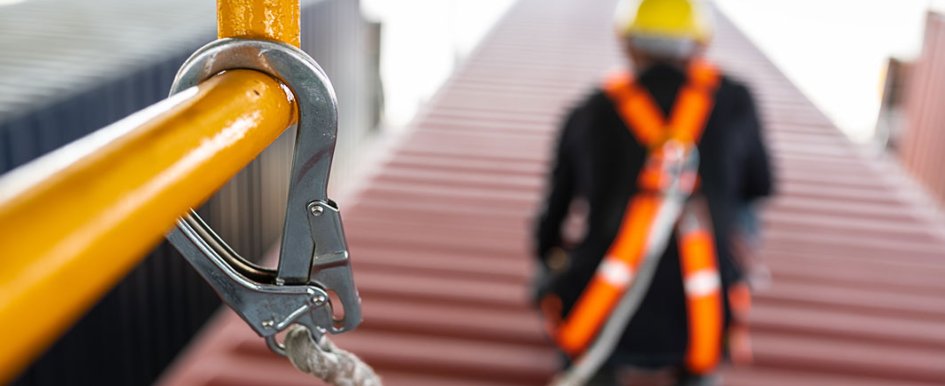
Fall protection remains the United States Occupational Safety and Health Administration’s (OSHA) most frequently cited rules violation, even after federal regulators sought to reduce fall-related fatalities with updated workplace safety rules towards the end of 2016.
Fatal falls today account for more than 15% of worker deaths. In our construction industry, fatal falls account for a little more than 33% of worker deaths. While fatal falls are the most worrisome result of a workplace rules violation, workplace injuries are also a cause for concern. Following is a count of fall-related injuries and deaths by industry, as recorded by the U.S. Bureau of Labor Statistics in 2017. Falls resulting in death in the construction industry surpassed the total for all seven other industries listed in this table.
| Industry | Injuries | Deaths |
|---|---|---|
| Construction | 24,700 | 384 |
| Manufacturing | 22,040 | 49 |
| Wholesale trade | 10,250 | 21 |
| Retail trade | 29,830 | 29 |
| Transportation and warehousing | 23,490 | 46 |
| Professional and business services | 22,090 | 111 |
| Education and health services | 43,660 | 18 |
| Government | 63,350 | 44 |
Of course, there are costs to your construction business in addition to devastating injury to or death of a valued worker. Workers' compensation and medical costs associated with occupational falls have been estimated at $70 billion annually in the U.S. In addition to the cost of workers’ compensation, there is the cost attributable to a project being short-staffed. Recruiting and training new workers also adds costs. Witnessing an injury or death to a coworker can create lasting trauma for fellow workers.
As in many unpleasant circumstances, injury and death resulting from falls can often be prevented. When three government agencies led by OSHA joined forces to provide education and enforcement of fall-prevention methods, they devised a three-step plan your company can use to develop a workplace fall-prevention program:
1. Plan Ahead to Keep From Looking Back With Regret
Prior to initiating any job at a construction jobsite; determine what portions will require workers to operate from a height. This includes trees, ladders, scaffolds, roofs, platforms, cranes and other motorized vehicles. During this planning phase, determine what safety equipment and training will be needed to keep construction workers safe from harm.
2. Provide Proper Safety Equipment to Workers
Fall protection gear and equipment, such as ladders and scaffolds, are required if workers are situated six feet or more above a lower level. It is useful to note many injuries and even deaths occur from heights of only six feet. In 2019, a worker in Pennsylvania fell to her death into a meat grinder from a set of wheeled stairs.
Because different ladders and scaffolds are appropriate for different types of jobs, check to be sure you are providing the correct equipment. Make sure each worker has a harness if the job requires the use of personal fall arrest systems (PFAS). Carefully inspect all equipment prior to use.
3. Train Workers to Use Safety Equipment Properly
Safety equipment won’t keep workers safe if isn’t properly used. It's that simple. Schedule training sessions during which workers can be taught the proper set up and use of any ladders, scaffolds, PFAS or any other safety equipment they'll be using on the job.
As in all things, common sense prevails when it comes to construction jobsite fall prevention.
- Be aware–Make sure employees are aware of the risk of jobsite falls. Signage indicating a gap, uneven ground or a slippery surface can anticipate a fall by raising awareness of a potentially dangerous situation.
- Take account of employees’ physical fitness–Physically fit employees will best meet potentially dangerous assignments.
- Keep surfaces dry, even and uncluttered–The need for surface hygiene should be intuitive, but is often forgotten in practice. Even one misplaced tool could cause a worker to stumble.
- Minimize work distractions–Texting and similar distractions have no place at dangerous jobsites.
- Access the benefits of wearable technology—Wearable technology can help increase jobsite safety by monitoring the wearer’s physical status and environmental conditions and issuing alerts when conditions become dangerous. For example, benefits of wearable technology in construction include heightening workers’ perceptual capabilities by helping them to see and hear more.
Trust a Fall Prevention Expert
The cost of a workplace fall can affect your company in a variety of ways. By reaching out to a fall-prevention expert who recognizes the danger signs and knows how to correct them, you can “catch” workplace falls before they occur.
Review your risk profile and insurance coverage for jobsite falls with your trusted risk management and insurance partner No amount of planning, equipment and training can be reliably counted upon to prevent all falls at the workplace.
Your trusted risk management and insurance partner can help your company manage the risk of death or injury from a fall through insurance and risk programs.
